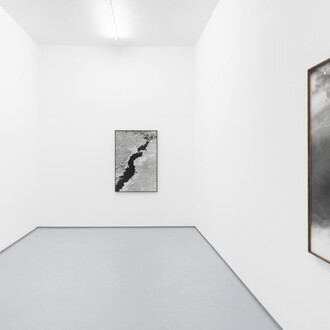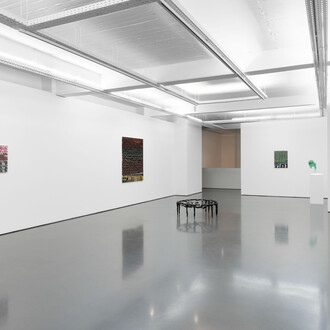Madragoa is delighted to present Gli esperti, the second solo exhibition of Enzo Cucchi (b. 1949, Morro d’Alba, Italy) at the gallery.
In the 1980s, Jurgis Baltrušaitis brought together three of his famous studies—on aberrations, anamorphoses, and the spread of the Isis myth in Western culture—under the definition of “depraved perspectives.”
This apparently strident expression turned out to be suitable to describe that interweaving, essential for art, in which a mental vision, rational, abstract, and superimposed on reality merges with a vision that captures the uninterrupted flow of reality and its continuous metamorphosis, that deviates from the order under a centrifugal force. The first one (the perspective, precisely) is geometrically structured and responds to the desire to frame things in a pre-established way, according to a precise and immutable point of view, while the second obeys instead the impulse for the deformation, the deviation; it is that oblique gaze, which captures what appears at the margin, as if seen from the corner of the eye. This latter view represents the metaphysical side, the reverse of the former, and only the dialectical relationship between the two, according to Baltrušaitis, determines the possibility of changing the usual perspectives that frame world and contributes to the history of knowledge. The Lithuanian art historian traces back to this relationship the concepts of “aberration” and “anamorphosis” that have been the object of his analysis over the years, combining studies on optics, on the migration of forms and the morphology of the legend. These concepts express the hybrid dimension of the work of art in which the representation of reality and the leap into the fantastic, the structured form and its distortion coexist, according to that doctrine of “depraved perspectives.”
The definitions of aberration and anamorphosis offer a compass with which to cross Enzo Cucchi’s exhibition, articulated in the two spaces of the gallery: the deviation from the norm, the hybridization and transfiguration of forms, and the optical deformation are to be found in the bronze sculptures, which creep into the exhibition space. Their presence is similar to a discreet incursion from the oneiric world that sometimes peeps out in everyday life and that here takes shape thanks to a diversion of mind, eye and hand. Like three-dimensional Rorschach blots, the sculptures Senza titolo and Buco di culo are mysterious epiphanies of objects split in half, showing a certain symmetry between the two parts of which they are composed. Installed at a corner of a column and a doorframe, the sculptures play hide-and-seek with visitors, revealing details, partial glimpses, showing their hybrid, organic, biomorphic, metamorphic nature.
The sculptures seem to take shape at the very moment of their impact with the architectural element to which they are anchored, to congeal in that instant, as if the still-melted bronze were molded in the contact with the wall, emphasizing the contrast between its white, straight and smooth surface and the flaming appearance of the loose form, which radiates vitality and vibrancy. The patina that coats Senza titolo gives it an earthy quality, while the other, very dark almost black in color, makes Buco di culo more visceral.
The title of the exhibition comes from the large painting on wood, Gli esperti, belonging to a recent series of large works in which, against a grey background, some figures appear: a toy skeleton, an inflatable shark, a rhinoceros that has lost its horn, an empty manger that suggests a nativity scene without the baby that seems to have slipped away.
The support consists of found and recovered wood panels, which bear imprinted on the surface traces of their previous use and the time they spent unprotected in an outdoor environment. The gray background has recorded splashes of paint, glue, shading and glazing with sharp contours, depending on the areas exposed to the sun. The wooden panel becomes a palimpsest on which the shadow of other overlapping panels has been impressed—the ghosts of other paintings. Its color and materiality make it similar to concrete, as if it were a portion of the floor of a painter’s studio rotated by ninety degrees, passing from the horizontal to the vertical dimension, a shift in perspective.
This double spatial dimension is reinforced in Gli esperti by a green ceramic insert that seems to be lying on its painted surface, and that almost acts as a headpiece for one of the small figures that cross the painting like a horizon, this light-blue firing squad that evokes the moai tufa sculptures of Easter Island.
Punctuating the wall in the other space of the gallery is an owl that, painted on a very small board, unfurls a ceramic tongue, which only returns its upside-down image, its elongated and garish shadow.
Enzo Cucchi was born in Morro d’Alba, Italy in 1949. Cucchi currently lives and works in Rome.
Since the 1970s, Cucchi has presented numerous solo exhibitions in institutions worldwide. Among these stand out the Stedelijk Museum, Amsterdam (1983), The Solomon R. Guggenheim Museum, New York (1986), Centre Georges Pompidou, Paris (1986), Städtische Galerie im Lenbachhaus, München (1987), Wiener Secession, Vienna (1988), Hamburger Kunsthalle, Hamburg (1992), Castello di Rivoli, Turin (1993), Sezon Museum of Art, Tokyo (1996), Deichtorhallen Hamburg, Hamburg (1999), Tel Aviv Museum of Art, Tel Aviv (1999 and 2001), and Villa Medici, Rome (2006).
















